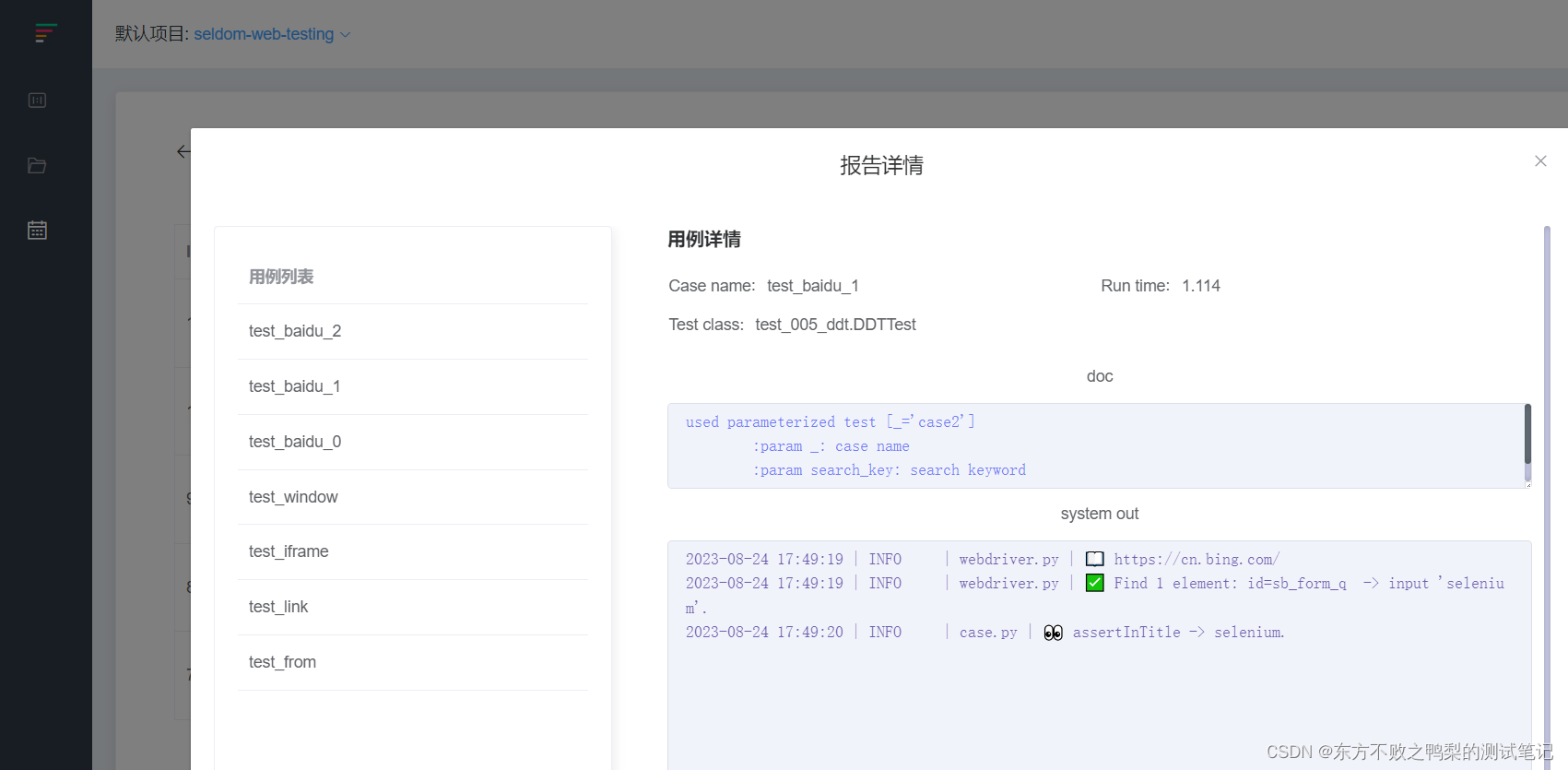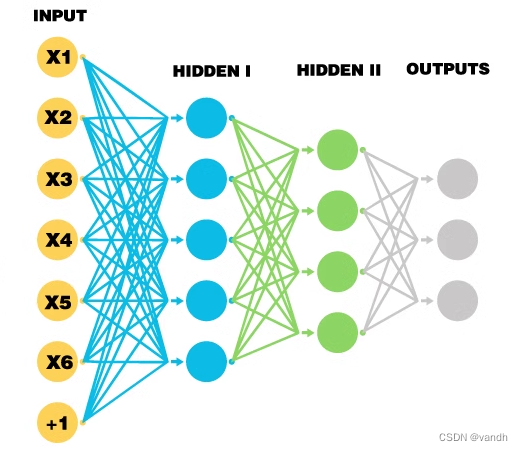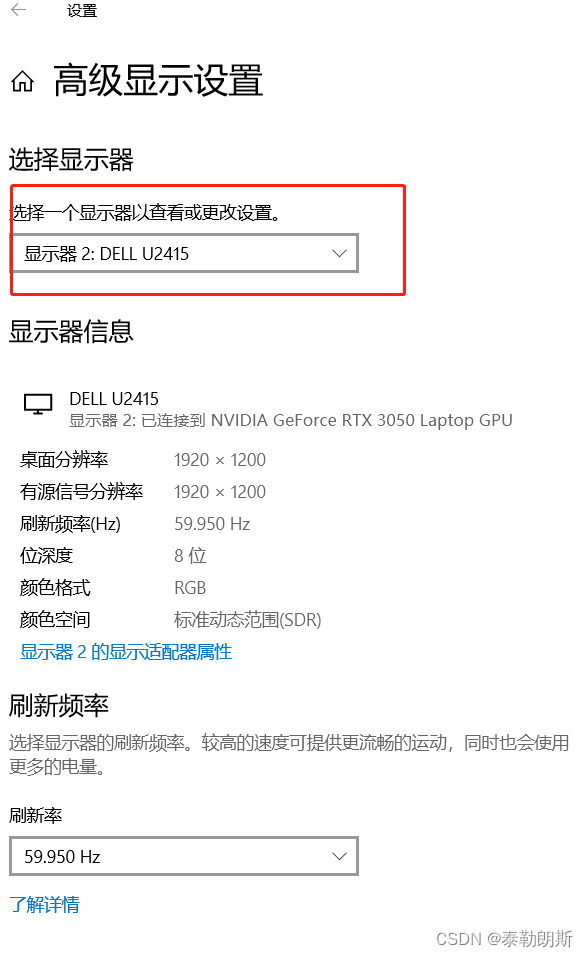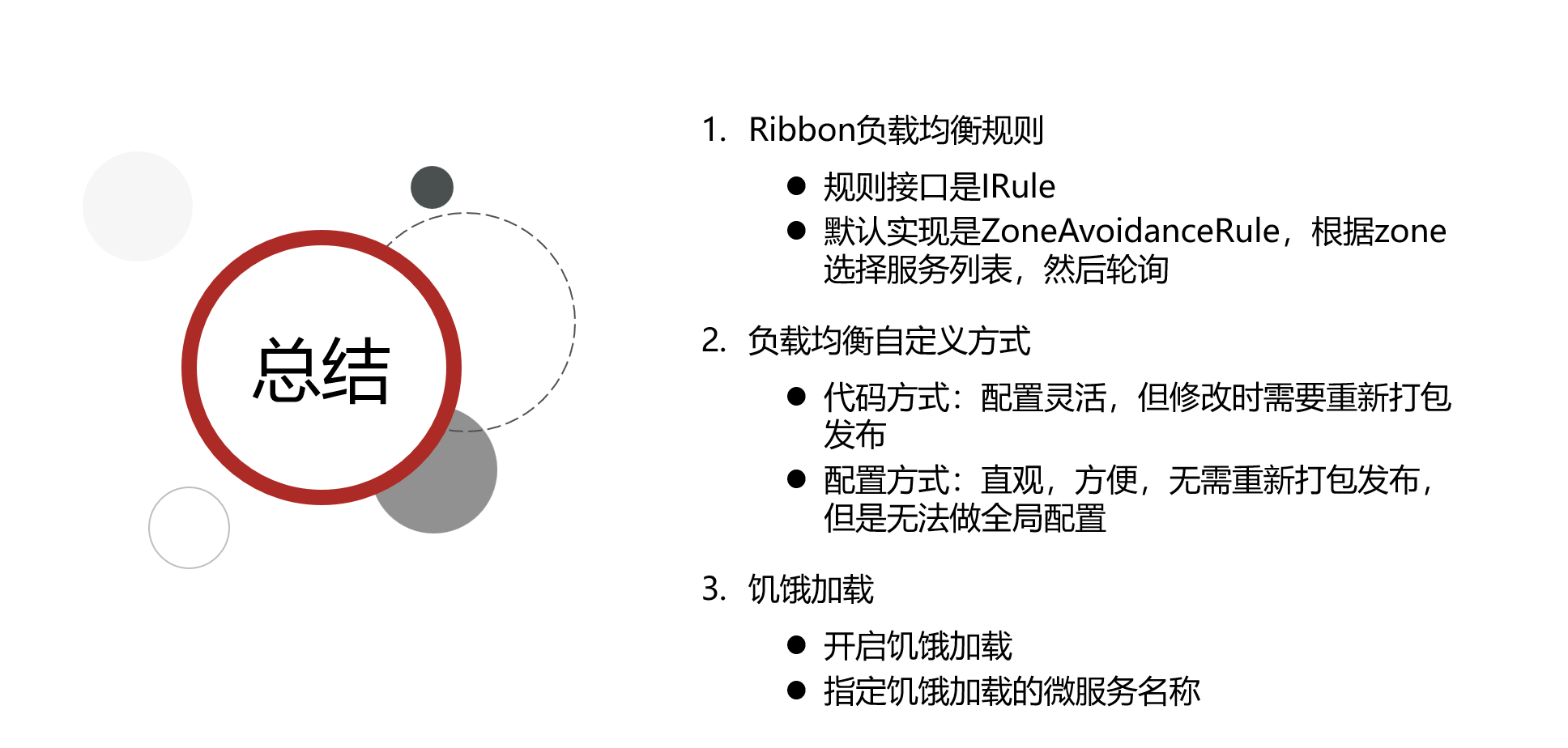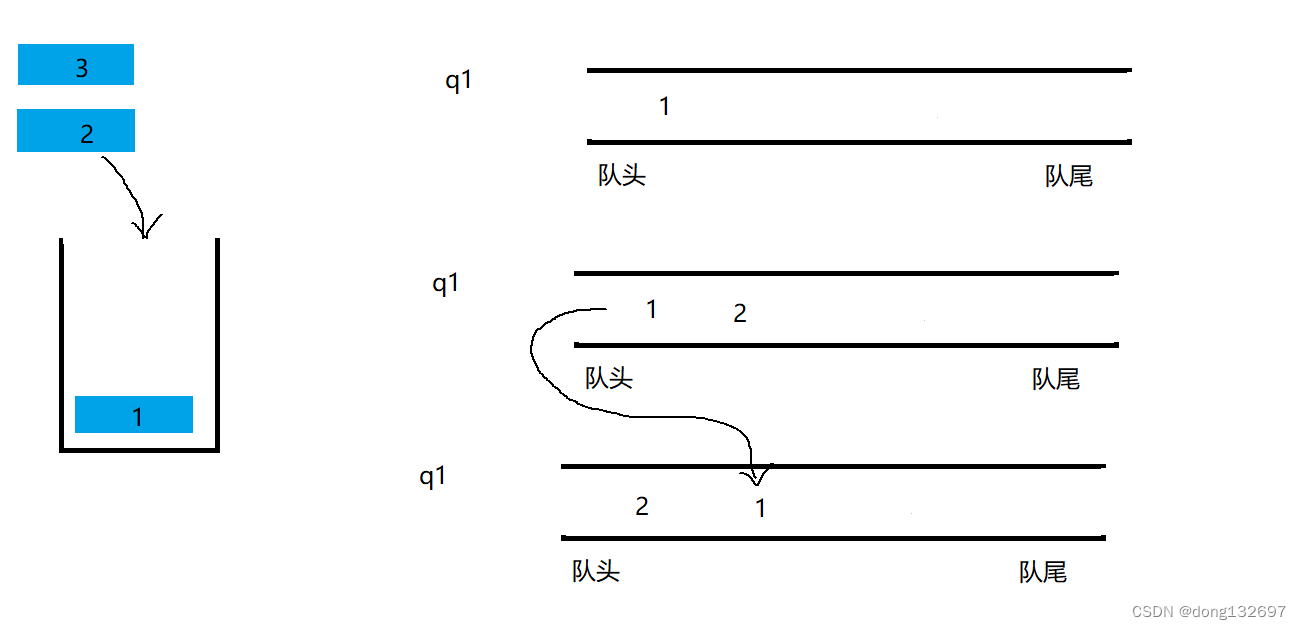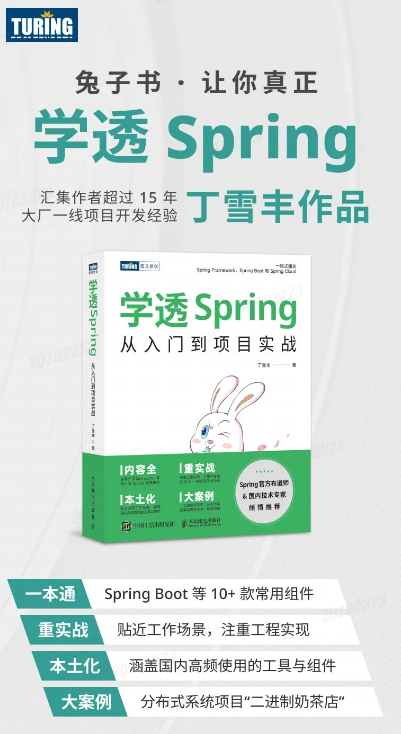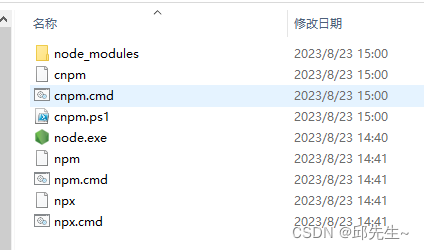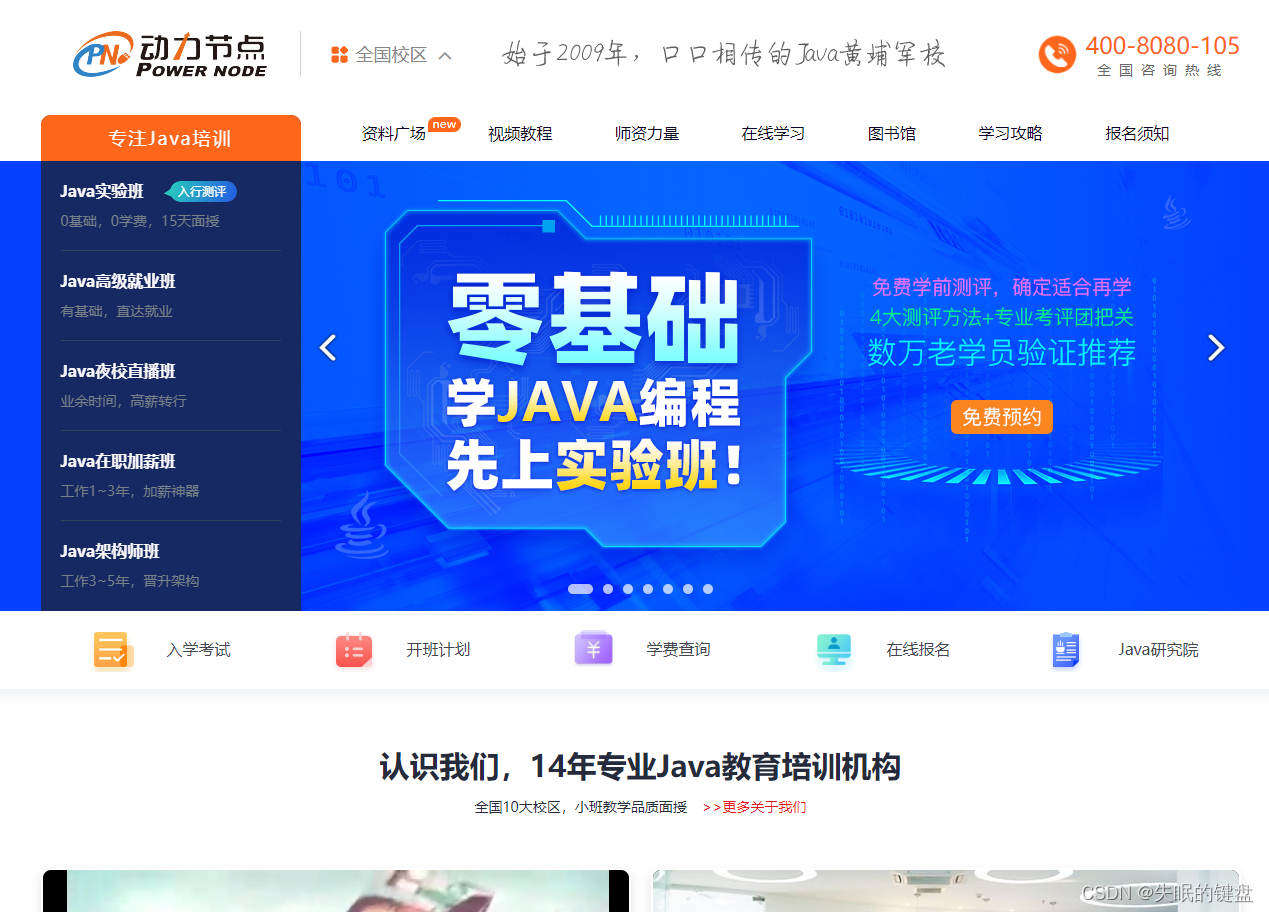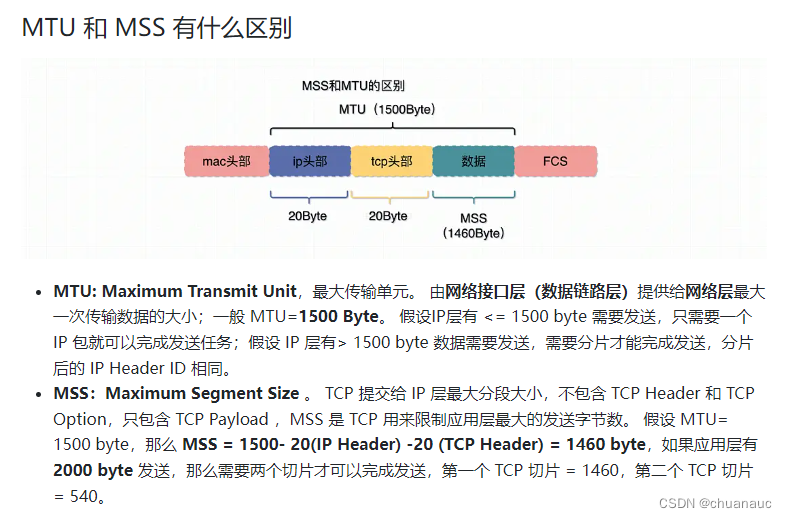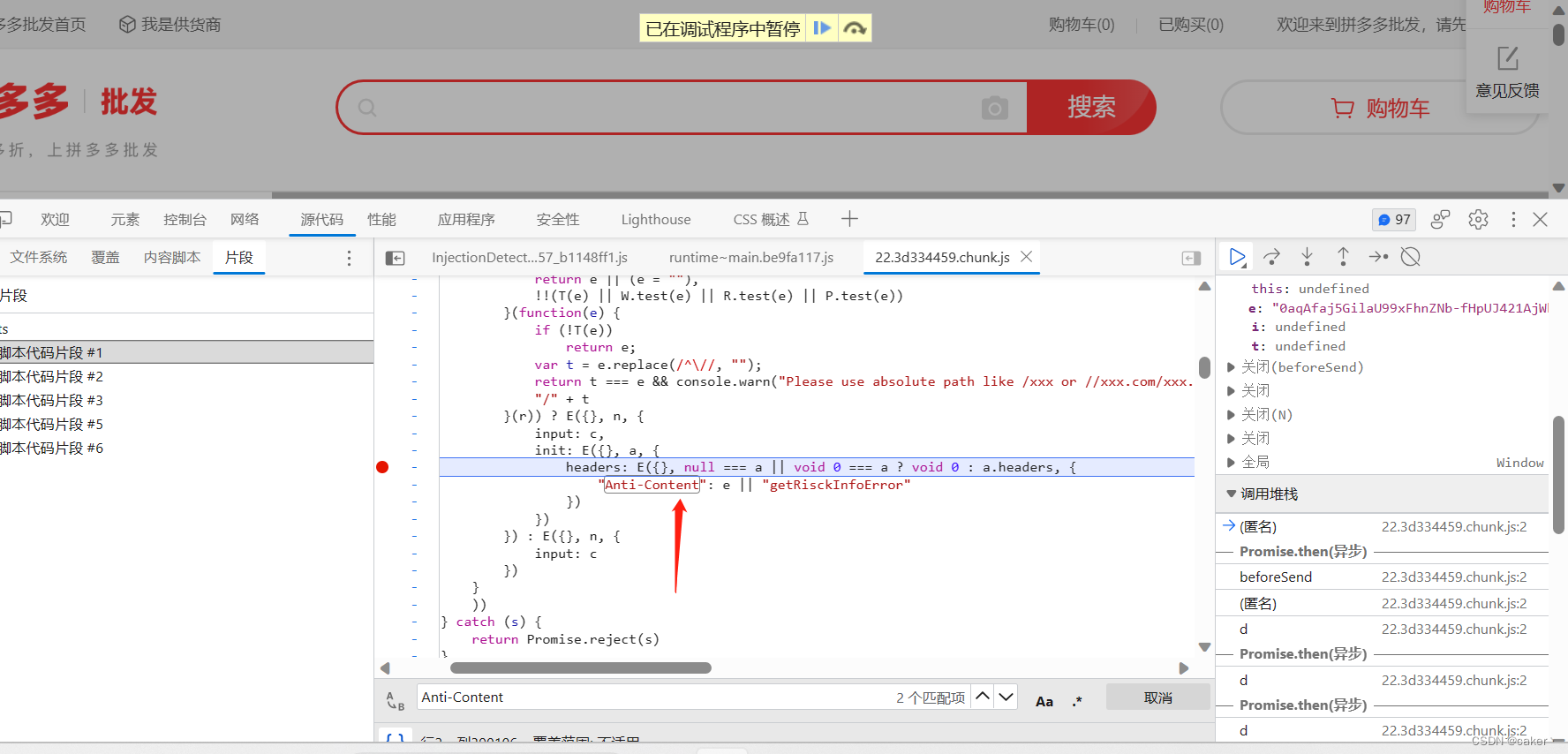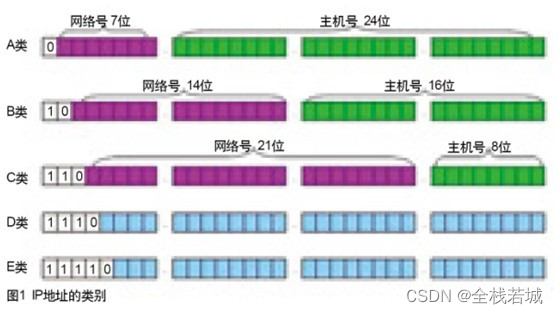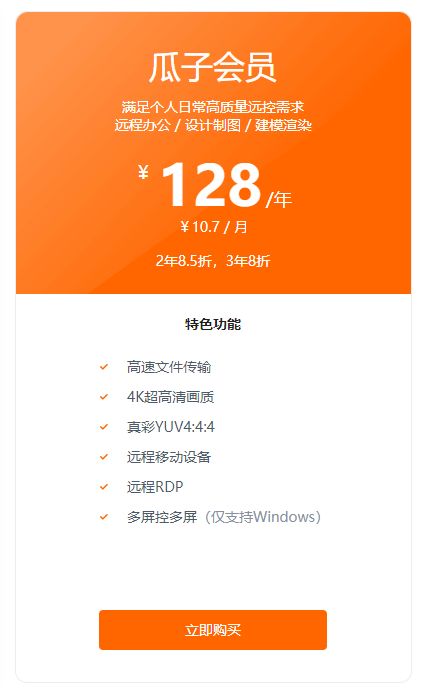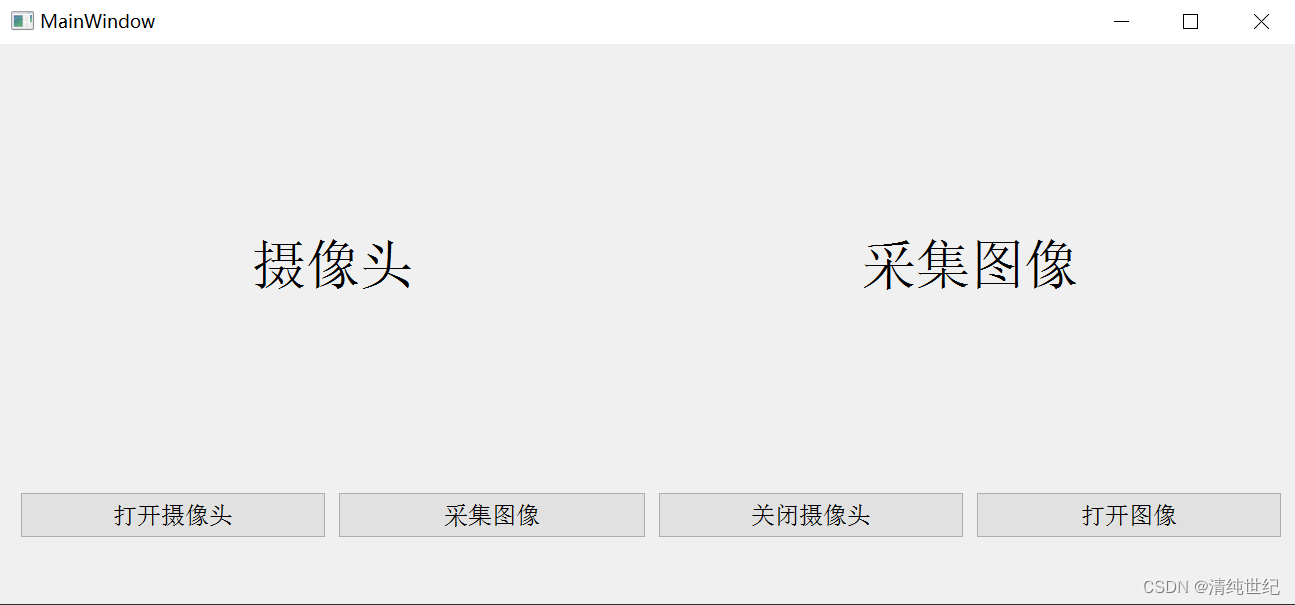目录
- 一、线程
- 1、初始化线程的 4 种方式
- 2、线程池的七大参数
- 3、线程池的运行流程:
- 4、例子
- 5、常见的 4 种线程池
- 6、开发中为什么使用线程池
- 二、CompletableFuture 异步编排
- 0、业务场景:
- 1、创建异步对象
- 2、计算完成时回调方法
- 3、handle 方法
- 4、线程串行化方法
- 5、两任务组合 - 都要完成
- 6、两任务组合 - 一个完成
- 7、多任务组合
- 三、测试代码
一、线程
1、初始化线程的 4 种方式
1)、继承 Thread
2)、实现 Runnable 接口
3)、实现 Callable 接口 + FutureTask (可以拿到返回结果,可以处理异常)
4)、线程池
方式 1 和方式 2:主进程无法获取线程的运算结果。不适合当前场景
方式 3:主进程可以获取线程的运算结果,但是不利于控制服务器中的线程资源。可以导致服务器资源耗尽。
方式 4:通过如下两种方式初始化线程池
Executors.newFiexedThreadPool(3);
//或者
new ThreadPoolExecutor(corePoolSize, maximumPoolSize, keepAliveTime, TimeUnit unit, workQueue, threadFactory, handler);
通过线程池性能稳定,也可以获取执行结果,并捕获异常。但是,在业务复杂情况下,一个异步调用可能会依赖于另一个异步调用的执行结果。
2、线程池的七大参数
* @param corePoolSize the number of threads to keep in the pool, even
* if they are idle, unless {@code allowCoreThreadTimeOut} is set
池中一直保持的线程的数量,即使线程空闲。除非设置了 allowCoreThreadTimeOut
* @param maximumPoolSize the maximum number of threads to allow in the
* pool
池中允许的最大的线程数
* @param keepAliveTime when the number of threads is greater than
* the core, this is the maximum time that excess idle threads
* will wait for new tasks before terminating. 当线程数大于核心线程数的时候,线程在最大多长时间没有接到新任务就会终止释放,
最终线程池维持在 corePoolSize 大小
* @param unit the time unit for the {@code keepAliveTime} argument
时间单位
* @param workQueue the queue to use for holding tasks before they are
* executed. This queue will hold only the {@code Runnable}
* tasks submitted by the {@code execute} method. 阻塞队列,用来存储等待执行的任务,如果当前对线程的需求超过了 corePoolSize
大小,就会放在这里等待空闲线程执行。
* @param threadFactory the factory to use when the executor
* creates a new thread
创建线程的工厂,比如指定线程名等
* @param handler the handler to use when execution is blocked
* because the thread bounds and queue capacities are reached
拒绝策略,如果线程满了,线程池就会使用拒绝策略。

3、线程池的运行流程:
1、线程池创建,准备好 core 数量的核心线程,准备接受任务
2、新的任务进来,用 core 准备好的空闲线程执行。
(1) 、core 满了,就将再进来的任务放入阻塞队列中。空闲的 core 就会自己去阻塞队列获取任务执行
(2) 、阻塞队列满了,就直接开新线程执行,最大只能开到 max 指定的数量
(3) 、max 都执行好了。Max-core 数量空闲的线程会在 keepAliveTime 指定的时间后自动销毁。最终保持到 core 大小
(4) 、如果线程数开到了 max 的数量,还有新任务进来,就会使用 reject 指定的拒绝策略进行处理
3、所有的线程创建都是由指定的 factory 创建的。
4、例子
一个线程池 core 7; max 20 ,queue:50,100 并发进来怎么分配的;
先有 7 个能直接得到执行,接下来 50 个进入队列排队,在多开 13 个继续执行。现在 70 个被安排上了。剩下 30 个默认拒绝策略。
5、常见的 4 种线程池
newCachedThreadPool
创建一个可缓存线程池,如果线程池长度超过处理需要,可灵活回收空闲线程,若无可回收,则新建线程。
newFixedThreadPool
创建一个定长线程池,可控制线程最大并发数,超出的线程会在队列中等待。
newScheduledThreadPool
创建一个定长线程池,支持定时及周期性任务执行。
newSingleThreadExecutor
创建一个单线程化的线程池,它只会用唯一的工作线程来执行任务,保证所有任务按照指定顺序(FIFO, LIFO, 优先级)执行。
6、开发中为什么使用线程池
1、降低资源消耗
通过重复利用已经创建好的线程降低线程的创建与销毁带来的损耗
2、提高响应速度
因为线程池中的线程数没有超过线程池最大上线时,有的线程处于等待分配任务的状态,当任务来时无需创建新的线程就能执行
3、提高线程的可管理性
线程池会根据当前系统的特点对池内的线程进行优化处理,减少创建和销毁线程带来的系统开销。无限的创建和销毁不仅消耗系统资源,还降低系统的稳定性,使用线程池进行统一分配。
二、CompletableFuture 异步编排
0、业务场景:
查询商品详情页的逻辑比较复杂,有些数据还需要远程调用,必然需要花费更多的时间。
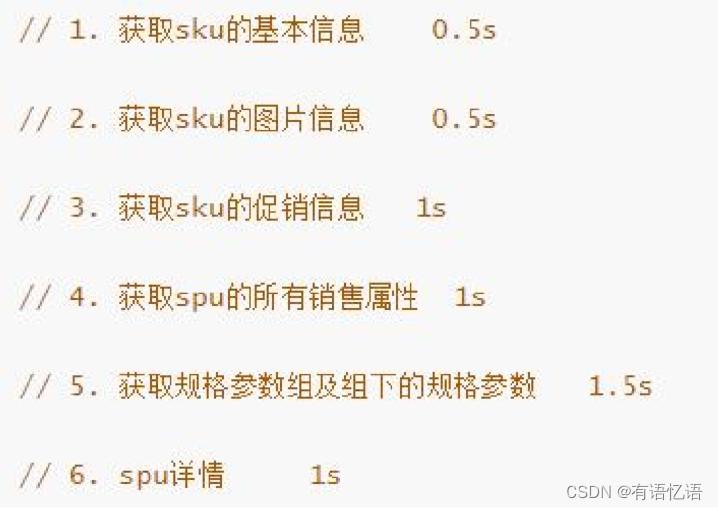
假如商品详情页的每个查询,需要如下标注的时间才能完成
那么,用户需要 5.5s 后才能看到商品详情页的内容。很显然是不能接受的。
如果有多个线程同时完成这 6 步操作,也许只需要 1.5s 即可完成响应。
Future是java5添加的类,用来描述一个异步计算的结果。你可以使用isDone方法检查计算是否完成,或者使用get阻塞住调用线程,知道计算完成返回结果,你也可以使用canel方法停止任务的执行。
虽然Future以及相关使用方法提供了异步执行任务的能力,但是对于结果的获取却是很不方便,只能通过阻塞或者轮询的方式得到任务的结果。阻塞的方式显然和我们的异步编程的初衷相违背,轮询的方式又会耗费无谓的 CPU 资源,而且也不能及时地得到计算结果,为什么不能用观察者设计模式当计算结果完成及时通知监听者呢?
很多语言,比如 Node.js,采用回调的方式实现异步编程。Java 的一些框架,比如 Netty,自己扩展了 Java 的 Future接口,提供了addListener等多个扩展方法;Google guava 也提供了通用的扩展 Future;Scala 也提供了简单易用且功能强大的 Future/Promise 异步编程模式。
作为正统的 Java 类库,是不是应该做点什么,加强一下自身库的功能呢?
在 Java 8 中, 新增加了一个包含 50 个方法左右的类: CompletableFuture,提供了非常强大的Future 的扩展功能,可以帮助我们简化异步编程的复杂性,提供了函数式编程的能力,可以通过回调的方式处理计算结果,并且提供了转换和组合 CompletableFuture 的方法。
CompletableFuture 类实现了 Future 接口,所以你还是可以像以前一样通过get方法阻塞或者轮询的方式获得结果,但是这种方式不推荐使用。
CompletableFuture 和 FutureTask 同属于 Future 接口的实现类,都可以获取线程的执行结果。
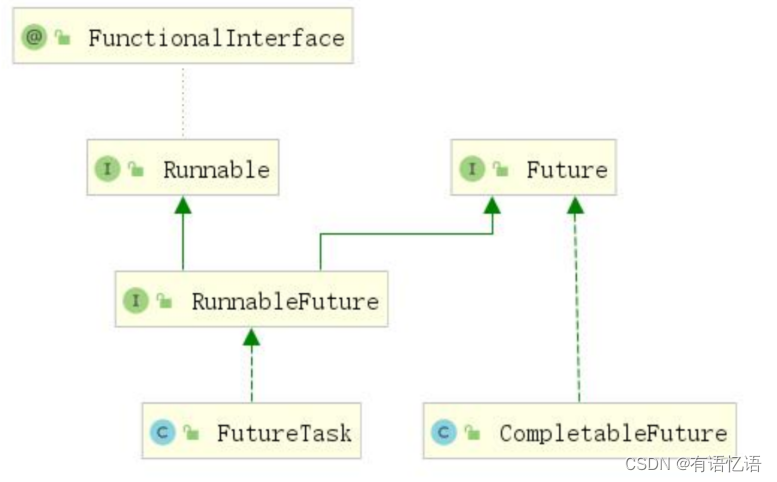
1、创建异步对象
CompletableFuture 提供了四个静态方法来创建一个异步操作。

1、runXxxx 都是没有返回结果的,supplyXxx 都是可以获取返回结果的
2、可以传入自定义的线程池,否则就用默认的线程池;
2、计算完成时回调方法

whenComplete 可以处理正常和异常的计算结果,exceptionally 处理异常情况。
whenComplete 和 whenCompleteAsync 的区别:
whenComplete:是执行当前任务的线程,继续执行 whenComplete 的任务。
whenCompleteAsync:是执行把 whenCompleteAsync 这个任务继续提交给线程池来进行执行。
方法不以 Async 结尾,意味着 Action 使用相同的线程执行,而 Async 可能会使用其他线程执行(如果是使用相同的线程池,也可能会被同一个线程选中执行)
public class CompletableFutureDemo {
public static void main(String[] args) throws ExecutionException, InterruptedException {
CompletableFuture future = CompletableFuture.supplyAsync(new Supplier<Object>() {
@Override
public Object get() {
System.out.println(Thread.currentThread().getName() + "\t
completableFuture");
int i = 10 / 0;
return 1024;
}
}).whenComplete(new BiConsumer<Object, Throwable>() {
@Override
public void accept(Object o, Throwable throwable) {
System.out.println("-------o=" + o.toString());
System.out.println("-------throwable=" + throwable);
}
}).exceptionally(new Function<Throwable, Object>() {
@Override
public Object apply(Throwable throwable) {
System.out.println("throwable=" + throwable);
return 6666;
}
});
System.out.println(future.get());
}
}
3、handle 方法

和 complete 一样,可对结果做最后的处理(可处理异常),可改变返回值。
4、线程串行化方法
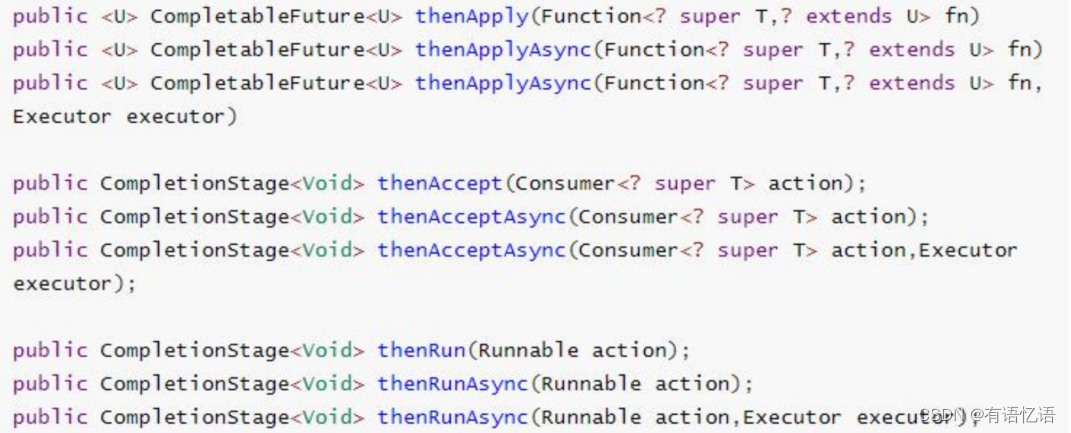 thenApply 方法:当一个线程依赖另一个线程时,获取上一个任务返回的结果,并返回当前任务的返回值。
thenApply 方法:当一个线程依赖另一个线程时,获取上一个任务返回的结果,并返回当前任务的返回值。
thenAccept 方法:消费处理结果。接收任务的处理结果,并消费处理,无返回结果。
thenRun 方法:只要上面的任务执行完成,就开始执行 thenRun,只是处理完任务后,执行thenRun 的后续操作
带有 Async 默认是异步执行的。同之前。
以上都要前置任务成功完成。
Function<? super T,? extends U>
T:上一个任务返回结果的类型
U:当前任务的返回值类型
5、两任务组合 - 都要完成
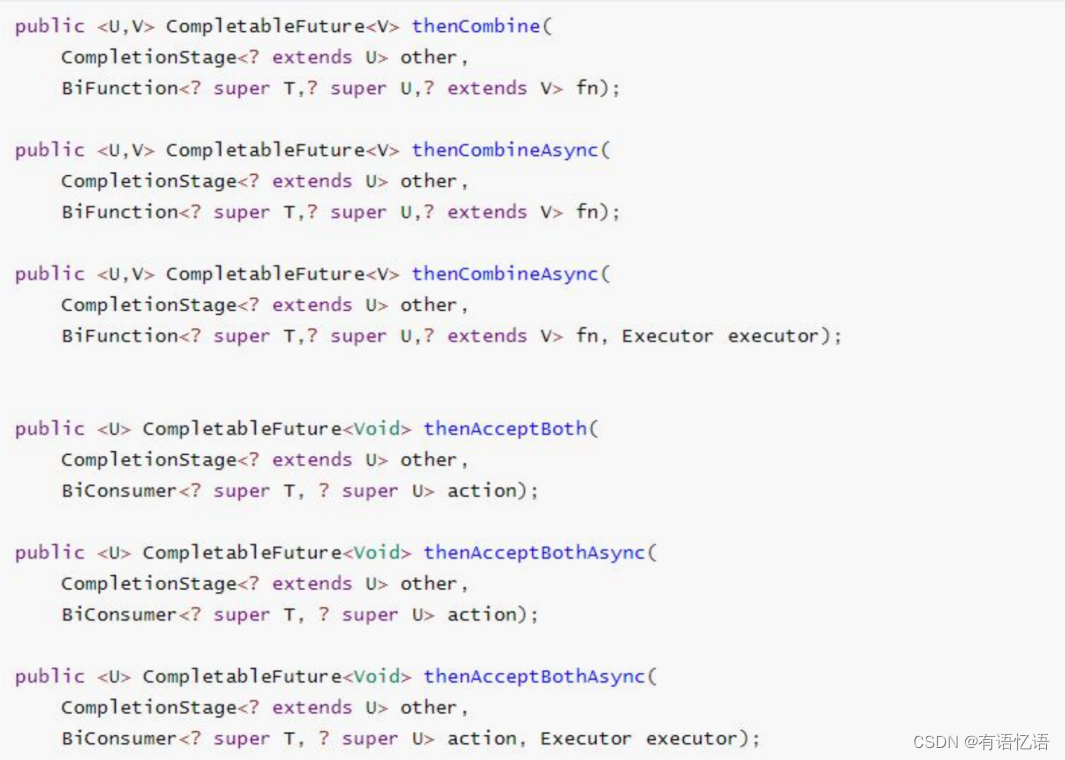

两个任务必须都完成,触发该任务。
thenCombine:组合两个 future,获取两个 future 的返回结果,并返回当前任务的返回值
thenAcceptBoth:组合两个 future,获取两个 future 任务的返回结果,然后处理任务,没有返回值。
runAfterBoth:组合两个 future,不需要获取 future 的结果,只需两个 future 处理完任务后,处理该任务。
6、两任务组合 - 一个完成
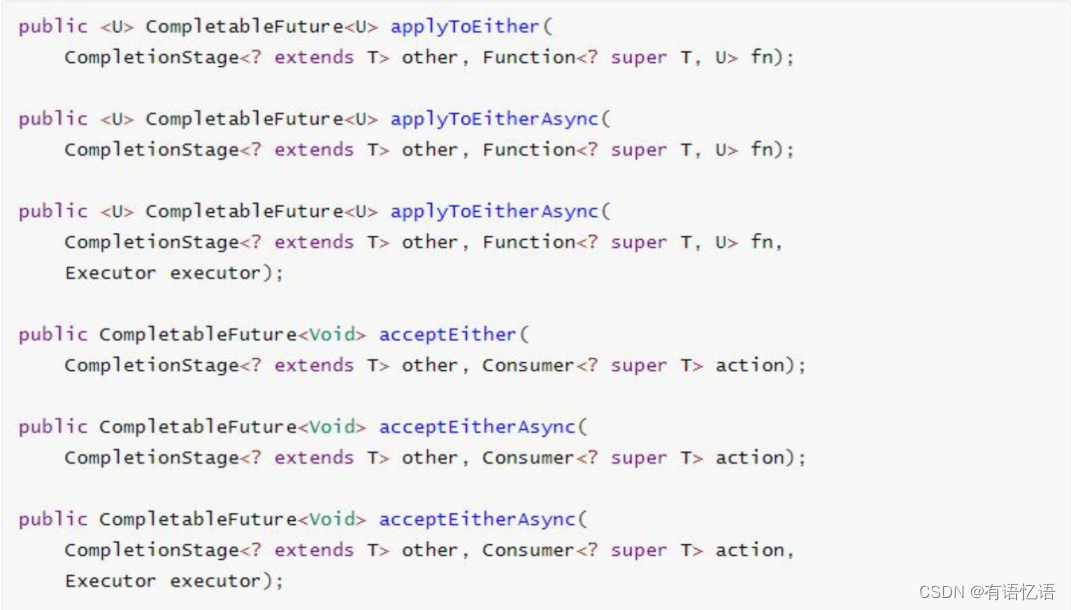

当两个任务中,任意一个 future 任务完成的时候,执行任务。
applyToEither:两个任务有一个执行完成,获取它的返回值,处理任务并有新的返回值。
acceptEither:两个任务有一个执行完成,获取它的返回值,处理任务,没有新的返回值。
runAfterEither:两个任务有一个执行完成,不需要获取 future 的结果,处理任务,也没有返回值。
7、多任务组合


三、测试代码
import java.util.concurrent.*;
public class ThreadTest {
public static ExecutorService executor = Executors.newFixedThreadPool(10);
public static void main(String[] args) throws ExecutionException, InterruptedException {
// System.out.println("main......start.....");
// Thread thread = new Thread01();
// thread.start();
// System.out.println("main......end.....");
// Runable01 runable01 = new Runable01();
// new Thread(runable01).start();
// FutureTask<Integer> futureTask = new FutureTask<>(new Callable01());
// new Thread(futureTask).start();
// System.out.println(futureTask.get());
// service.execute(new Runable01());
// Future<Integer> submit = service.submit(new Callable01());
// submit.get();
System.out.println("main......start.....");
// CompletableFuture<Void> future = CompletableFuture.runAsync(() -> {
// System.out.println("当前线程:" + Thread.currentThread().getId());
// int i = 10 / 2;
// System.out.println("运行结果:" + i);
// }, executor);
/**
* 方法完成后的处理
*/
// CompletableFuture<Integer> future = CompletableFuture.supplyAsync(() -> {
// System.out.println("当前线程:" + Thread.currentThread().getId());
// int i = 10 / 0;
// System.out.println("运行结果:" + i);
// return i;
// }, executor).whenComplete((res,exception) -> {
// //虽然能得到异常信息,但是没法修改返回数据
// System.out.println("异步任务成功完成了...结果是:" + res + "异常是:" + exception);
// }).exceptionally(throwable -> {
// //可以感知异常,同时返回默认值
// return 10;
// });
/**
* 方法执行完后端处理
*/
// CompletableFuture<Integer> future = CompletableFuture.supplyAsync(() -> {
// System.out.println("当前线程:" + Thread.currentThread().getId());
// int i = 10 / 2;
// System.out.println("运行结果:" + i);
// return i;
// }, executor).handle((result,thr) -> {
// if (result != null) {
// return result * 2;
// }
// if (thr != null) {
// System.out.println("异步任务成功完成了...结果是:" + result + "异常是:" + thr);
// return 0;
// }
// return 0;
// });
/**
* 线程串行化
* 1、thenRunL:不能获取上一步的执行结果
* 2、thenAcceptAsync:能接受上一步结果,但是无返回值
* 3、thenApplyAsync:能接受上一步结果,有返回值
*
*/
CompletableFuture<String> future = CompletableFuture.supplyAsync(() -> {
System.out.println("当前线程:" + Thread.currentThread().getId());
int i = 10 / 2;
System.out.println("运行结果:" + i);
return i;
}, executor).thenApplyAsync(res -> {
System.out.println("任务2启动了..." + res);
return "Hello" + res;
}, executor);
System.out.println("main......end....." + future.get());
}
private static void threadPool() {
ExecutorService threadPool = new ThreadPoolExecutor(
200,
10,
10L,
TimeUnit.SECONDS,
new LinkedBlockingDeque<Runnable>(10000),
Executors.defaultThreadFactory(),
new ThreadPoolExecutor.AbortPolicy()
);
//定时任务的线程池
ExecutorService service = Executors.newScheduledThreadPool(2);
}
public static class Thread01 extends Thread {
@Override
public void run() {
System.out.println("当前线程:" + Thread.currentThread().getId());
int i = 10 / 2;
System.out.println("运行结果:" + i);
}
}
public static class Runable01 implements Runnable {
@Override
public void run() {
System.out.println("当前线程:" + Thread.currentThread().getId());
int i = 10 / 2;
System.out.println("运行结果:" + i);
}
}
public static class Callable01 implements Callable<Integer> {
@Override
public Integer call() throws Exception {
System.out.println("当前线程:" + Thread.currentThread().getId());
int i = 10 / 2;
System.out.println("运行结果:" + i);
return i;
}
}
}
